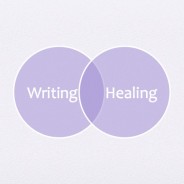Posted by Diane Morrow on October 26, 2006 in Healing Images, Invitation

Not all writing is done with the intent of healing. And not all healing requires writing. Perhaps this is obvious–but perhaps it’s also worth saying upfront. I’m interested in the place where the two might overlap. The place where writing and healing might overlap. I’m also aware that each person’s area of overlap might be somewhat different. A tiny sliver? A wide swath? And, at this place of overlap–intersection–I found an article of particular interest: Writing Well: Health and the Power to Make Images. The article, written by Mark Robinson, a poet and critic in England, appears in the journal, Medical Humanities. In the article, Robinson presents his hypothesis: “that the writing process itself is an integral part of any [health] benefit.” In other words, those same elements that foster good writing may also be some of the same elements that foster health. And one such element is the use of vivid imagery. The entire article is available online, and is well worth reading, but I’ll mention a few highlights here: • Virginia Woolf, in a diary entry from 1926, links her depression to having “no power of phrase making.” In turn, she links her lifting of depression with a gradual recovery of the ability to write. She writes: “Returning health: this is shown by the power to make images; the suggestive power of every sight and word is enormously increased.” • In a survey of 34 poets—including not only poets receiving mental health services, but also poets with no particular physical or mental illness history and poets with several published books—84% responded that writing had had a therapeutic use for them. These poets reported that they’d used writing to deal with stressful incidents in their lives, including the death of parents and children. They reported using writing, among other things, to deal with emotions, to sort out thoughts, and to provide a means of catharsis. • Interestingly, a number of these poets who were surveyed reported that when they did not write as regularly as they wanted they experienced negative mental and physical effects. More than one poet mentioned that when (s)he was able to begin writing regularly again (s)he felt better. • Finally, Robinson also reports on some work—a bit complex—but very interesting—in which a professor at Adelphi University, Wilma Bucci, proposes a model for why writing has an effect on physical and emotional health. She proposes that writing works particularly well at stimulating health when the language of writing is grounded in specific and concrete images. She describes a process whereby a person begins with a kind of amorphous knowing and then through the process of writing begins to form images, allowing for a “breakthrough in writing.” A person moves from amorphous—literally no form—to an image. A form. A shape. A something. And this breakthrough can foster health. This last point seems to resonate with Virginia Woolf’s reported experience (thus the title of Robinson’s article) and also resonates with my own experience. When something that has been amorphous emerges as an image—a concrete something with a concrete name—this can offer a kind of breakthrough—and that breakthrough can both make for better writing, and at the same time, it can feel good—it can look and feel like...
read more

